Jakob Schoeffer
Perils of Label Indeterminacy: A Case Study on Prediction of Neurological Recovery After Cardiac Arrest
Apr 05, 2025



Abstract:The design of AI systems to assist human decision-making typically requires the availability of labels to train and evaluate supervised models. Frequently, however, these labels are unknown, and different ways of estimating them involve unverifiable assumptions or arbitrary choices. In this work, we introduce the concept of label indeterminacy and derive important implications in high-stakes AI-assisted decision-making. We present an empirical study in a healthcare context, focusing specifically on predicting the recovery of comatose patients after resuscitation from cardiac arrest. Our study shows that label indeterminacy can result in models that perform similarly when evaluated on patients with known labels, but vary drastically in their predictions for patients where labels are unknown. After demonstrating crucial ethical implications of label indeterminacy in this high-stakes context, we discuss takeaways for evaluation, reporting, and design.
A Critical Survey on Fairness Benefits of XAI
Oct 15, 2023



Abstract:In this critical survey, we analyze typical claims on the relationship between explainable AI (XAI) and fairness to disentangle the multidimensional relationship between these two concepts. Based on a systematic literature review and a subsequent qualitative content analysis, we identify seven archetypal claims from 175 papers on the alleged fairness benefits of XAI. We present crucial caveats with respect to these claims and provide an entry point for future discussions around the potentials and limitations of XAI for specific fairness desiderata. While the literature often suggests XAI to be an enabler for several fairness desiderata, we notice a misalignment between these desiderata and the capabilities of XAI. We encourage to conceive XAI as one of many tools to approach the multidimensional, sociotechnical challenge of algorithmic fairness and to be more specific about how exactly what kind of XAI method enables whom to address which fairness desideratum.
On the Interdependence of Reliance Behavior and Accuracy in AI-Assisted Decision-Making
Apr 18, 2023



Abstract:In AI-assisted decision-making, a central promise of putting a human in the loop is that they should be able to complement the AI system by adhering to its correct and overriding its mistaken recommendations. In practice, however, we often see that humans tend to over- or under-rely on AI recommendations, meaning that they either adhere to wrong or override correct recommendations. Such reliance behavior is detrimental to decision-making accuracy. In this work, we articulate and analyze the interdependence between reliance behavior and accuracy in AI-assisted decision-making, which has been largely neglected in prior work. We also propose a visual framework to make this interdependence more tangible. This framework helps us interpret and compare empirical findings, as well as obtain a nuanced understanding of the effects of interventions (e.g., explanations) in AI-assisted decision-making. Finally, we infer several interesting properties from the framework: (i) when humans under-rely on AI recommendations, there may be no possibility for them to complement the AI in terms of decision-making accuracy; (ii) when humans cannot discern correct and wrong AI recommendations, no such improvement can be expected either; (iii) interventions may lead to an increase in decision-making accuracy that is solely driven by an increase in humans' adherence to AI recommendations, without any ability to discern correct and wrong. Our work emphasizes the importance of measuring and reporting both effects on accuracy and reliance behavior when empirically assessing interventions.
On Explanations, Fairness, and Appropriate Reliance in Human-AI Decision-Making
Sep 23, 2022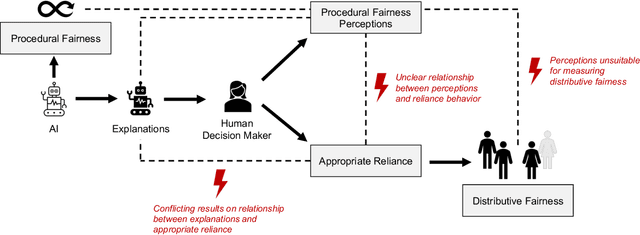

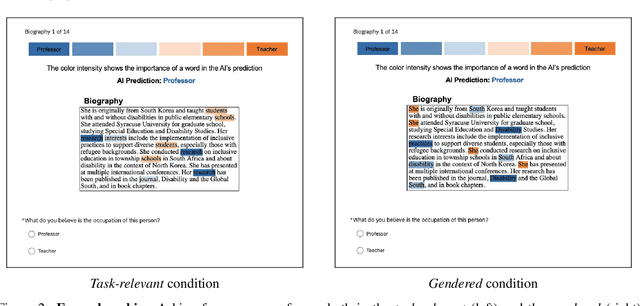

Abstract:Explanations have been framed as an essential feature for better and fairer human-AI decision-making. In the context of fairness, this has not been appropriately studied, as prior works have mostly evaluated explanations based on their effects on people's perceptions. We argue, however, that for explanations to promote fairer decisions, they must enable humans to discern correct and wrong AI recommendations. To validate our conceptual arguments, we conduct an empirical study to examine the relationship between explanations, fairness perceptions, and reliance behavior. Our findings show that explanations influence people's fairness perceptions, which, in turn, affect reliance. However, we observe that low fairness perceptions lead to more overrides of AI recommendations, regardless of whether they are correct or wrong. This (i) raises doubts about the usefulness of existing explanations for enhancing distributive fairness, and, (ii) makes an important case for why perceptions must not be confused as a proxy for appropriate reliance.
"There Is Not Enough Information": On the Effects of Explanations on Perceptions of Informational Fairness and Trustworthiness in Automated Decision-Making
May 11, 2022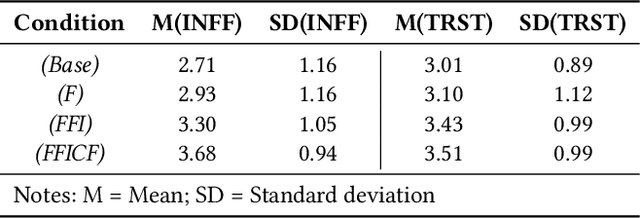

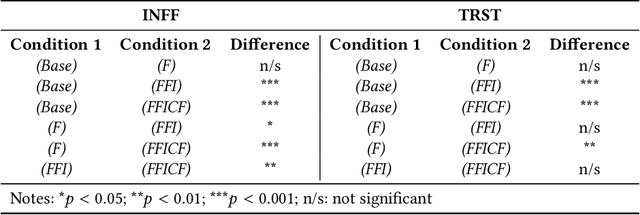
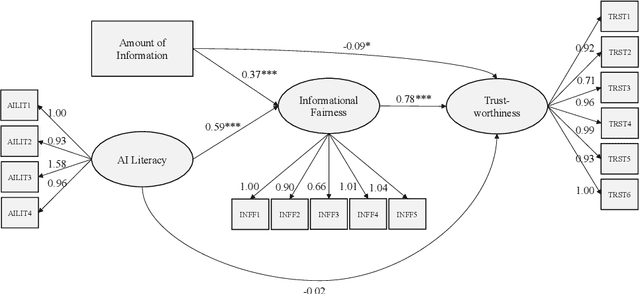
Abstract:Automated decision systems (ADS) are increasingly used for consequential decision-making. These systems often rely on sophisticated yet opaque machine learning models, which do not allow for understanding how a given decision was arrived at. In this work, we conduct a human subject study to assess people's perceptions of informational fairness (i.e., whether people think they are given adequate information on and explanation of the process and its outcomes) and trustworthiness of an underlying ADS when provided with varying types of information about the system. More specifically, we instantiate an ADS in the area of automated loan approval and generate different explanations that are commonly used in the literature. We randomize the amount of information that study participants get to see by providing certain groups of people with the same explanations as others plus additional explanations. From our quantitative analyses, we observe that different amounts of information as well as people's (self-assessed) AI literacy significantly influence the perceived informational fairness, which, in turn, positively relates to perceived trustworthiness of the ADS. A comprehensive analysis of qualitative feedback sheds light on people's desiderata for explanations, among which are (i) consistency (both with people's expectations and across different explanations), (ii) disclosure of monotonic relationships between features and outcome, and (iii) actionability of recommendations.
A Human-Centric Perspective on Fairness and Transparency in Algorithmic Decision-Making
Apr 29, 2022
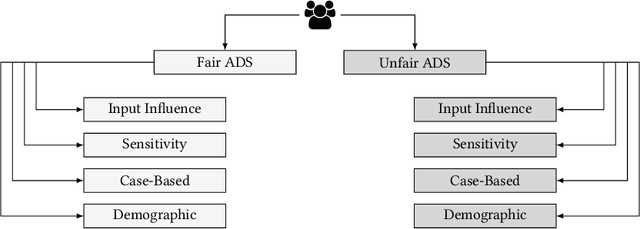
Abstract:Automated decision systems (ADS) are increasingly used for consequential decision-making. These systems often rely on sophisticated yet opaque machine learning models, which do not allow for understanding how a given decision was arrived at. This is not only problematic from a legal perspective, but non-transparent systems are also prone to yield unfair outcomes because their sanity is challenging to assess and calibrate in the first place -- which is particularly worrisome for human decision-subjects. Based on this observation and building upon existing work, I aim to make the following three main contributions through my doctoral thesis: (a) understand how (potential) decision-subjects perceive algorithmic decisions (with varying degrees of transparency of the underlying ADS), as compared to similar decisions made by humans; (b) evaluate different tools for transparent decision-making with respect to their effectiveness in enabling people to appropriately assess the quality and fairness of ADS; and (c) develop human-understandable technical artifacts for fair automated decision-making. Over the course of the first half of my PhD program, I have already addressed substantial pieces of (a) and (c), whereas (b) will be the major focus of the second half.
On the Relationship Between Explanations, Fairness Perceptions, and Decisions
Apr 29, 2022
Abstract:It is known that recommendations of AI-based systems can be incorrect or unfair. Hence, it is often proposed that a human be the final decision-maker. Prior work has argued that explanations are an essential pathway to help human decision-makers enhance decision quality and mitigate bias, i.e., facilitate human-AI complementarity. For these benefits to materialize, explanations should enable humans to appropriately rely on AI recommendations and override the algorithmic recommendation when necessary to increase distributive fairness of decisions. The literature, however, does not provide conclusive empirical evidence as to whether explanations enable such complementarity in practice. In this work, we (a) provide a conceptual framework to articulate the relationships between explanations, fairness perceptions, reliance, and distributive fairness, (b) apply it to understand (seemingly) contradictory research findings at the intersection of explanations and fairness, and (c) derive cohesive implications for the formulation of research questions and the design of experiments.
Perceptions of Fairness and Trustworthiness Based on Explanations in Human vs. Automated Decision-Making
Sep 13, 2021
Abstract:Automated decision systems (ADS) have become ubiquitous in many high-stakes domains. Those systems typically involve sophisticated yet opaque artificial intelligence (AI) techniques that seldom allow for full comprehension of their inner workings, particularly for affected individuals. As a result, ADS are prone to deficient oversight and calibration, which can lead to undesirable (e.g., unfair) outcomes. In this work, we conduct an online study with 200 participants to examine people's perceptions of fairness and trustworthiness towards ADS in comparison to a scenario where a human instead of an ADS makes a high-stakes decision -- and we provide thorough identical explanations regarding decisions in both cases. Surprisingly, we find that people perceive ADS as fairer than human decision-makers. Our analyses also suggest that people's AI literacy affects their perceptions, indicating that people with higher AI literacy favor ADS more strongly over human decision-makers, whereas low-AI-literacy people exhibit no significant differences in their perceptions.
Appropriate Fairness Perceptions? On the Effectiveness of Explanations in Enabling People to Assess the Fairness of Automated Decision Systems
Aug 14, 2021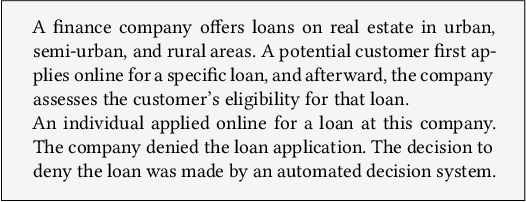
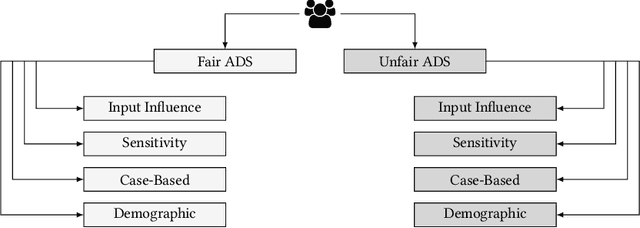
Abstract:It is often argued that one goal of explaining automated decision systems (ADS) is to facilitate positive perceptions (e.g., fairness or trustworthiness) of users towards such systems. This viewpoint, however, makes the implicit assumption that a given ADS is fair and trustworthy, to begin with. If the ADS issues unfair outcomes, then one might expect that explanations regarding the system's workings will reveal its shortcomings and, hence, lead to a decrease in fairness perceptions. Consequently, we suggest that it is more meaningful to evaluate explanations against their effectiveness in enabling people to appropriately assess the quality (e.g., fairness) of an associated ADS. We argue that for an effective explanation, perceptions of fairness should increase if and only if the underlying ADS is fair. In this in-progress work, we introduce the desideratum of appropriate fairness perceptions, propose a novel study design for evaluating it, and outline next steps towards a comprehensive experiment.
A Study on Fairness and Trust Perceptions in Automated Decision Making
Mar 08, 2021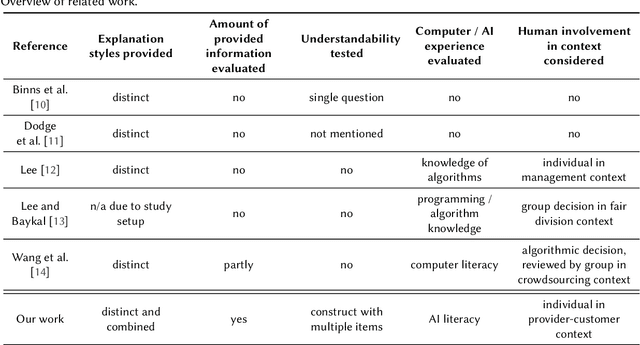

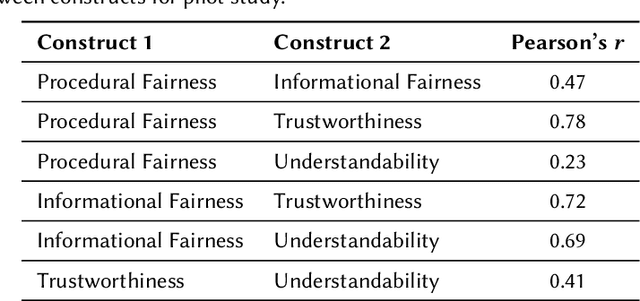
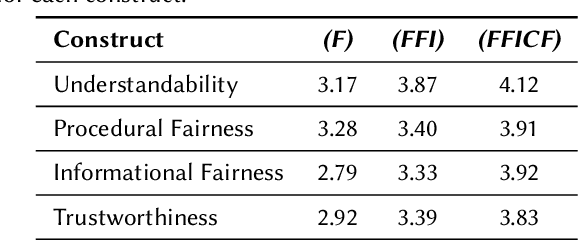
Abstract:Automated decision systems are increasingly used for consequential decision making -- for a variety of reasons. These systems often rely on sophisticated yet opaque models, which do not (or hardly) allow for understanding how or why a given decision was arrived at. This is not only problematic from a legal perspective, but non-transparent systems are also prone to yield undesirable (e.g., unfair) outcomes because their sanity is difficult to assess and calibrate in the first place. In this work, we conduct a study to evaluate different attempts of explaining such systems with respect to their effect on people's perceptions of fairness and trustworthiness towards the underlying mechanisms. A pilot study revealed surprising qualitative insights as well as preliminary significant effects, which will have to be verified, extended and thoroughly discussed in the larger main study.
 Add to Chrome
Add to Chrome Add to Firefox
Add to Firefox Add to Edge
Add to Edge